Mechanically flexible and flame-retardant cellulose nanofibril-based films integrated with MXene and chitosan
Abstract
Remarkable flame-retardant and integrated mechanical properties are essential requirements for the potential applications of bio-based films in industrial areas. Unfortunately, the design and fabrication of such film materials that possess a good trade-off between mechanical properties and flame-retardant performance remain significant challenges. Here, phosphorylated cellulose nanofibril-based films (PCNFs) integrated with chitosan (CS) and MXene (PCNF/CS-M) are fabricated via a facile water evaporation-induced self-assembly method. An evident reinforcement of the mechanical performance can be achieved by constructing additional interactions (i.e., hydrogen bonding and nanoreinforcement) among the hybrid network, which endows the optimized films with highly improved and balanced mechanical performance (i.e., tensile strength of 172.1 MPa, tensile strain of 8.0%, Young’s modulus of 4.4 GPa and toughness of 8.5 MJ/m-3). Furthermore, the resultant films also exhibit outstanding flame resistance, as clearly illustrated by their structural integrity after cyclic testing using a butane lamp flame at 700-800 °C. The synergistic reinforcing and flame-retardant mechanisms of the films are clarified based on structural evolution and performance variation. The strategy developed herein provides an innovative concept for designing and developing advanced bio-based film materials for fireproof coatings.
Keywords
INTRODUCTION
Polymer materials based on natural biopolymers (e.g., starch, alginate, and so on)[1-4] that integrate mechanical flexibility, biodegradability and inexpensiveness are of great importance for achieving the goals of carbon neutrality and sustainable development. Cellulose nanofibrils (CNFs), as bio-based nanomaterials with a filamentous morphology[5] and tunable surface charge characteristics[6], have attracted tremendous research interest due to their abundant reserves and excellent overall performance[7,8]. Compared to conventional biopolymers, the unique nanoscale and hydrophilic features of CNFs empower them with a high aspect ratio, good water dispersibility and favorable processibility[9-11]. Therefore, they are promising candidates for achieving film materials with good integrated performance, including high stretchability and transparency. Unfortunately, due to their inherently inflammable nature, CNF-based film structures are easily disaggregated when directly exposed to heat corrosion or flame attack, resulting in major obstacles to their development and applications from bench to market. Thus, it remains a significant challenge to develop novel CNF-based films with excellent flame-retardant performance.
To tackle the above issue, various strategies have been continuously explored in recent years, such as chemical treatment with phosphorus-containing reagents[12] and introducing flame-retardant compounds[13,14] and nanomaterials[15] into the matrix. However, when using a single strategy, achieving a good trade-off between mechanical properties and flame-retardant performance is challenging. As an exciting family of layered nanomaterials, MXene (two-dimensional transition-metal carbides and/or nitrides) sheets have triggered extensive research in a vast array of applications due to their high aspect ratio morphology and excellent mechanical performance[16]. Interestingly, MXenes also exhibit outstanding flame resistance and good water dispersibility because of their inorganic backbone and rich surface hydrophilic moieties[17]. Considering the typical method, i.e., the water evaporation-induced self-assembly process, for fabricating CNF-based films[18], as nanofillers, integrating CNFs with MXenes (water system) is a reasonable approach to obtain flame-retardant composite materials. Li et al. developed an improved flame-resistant composite aerogel composed of lignocellulose nanofibrils, MXene and gelatin[19]. Notably, the mechanical performance of the aerogel was not desirable, e.g., a weakened recovery ability, which is closely related to the interactions among components. Therefore, regulating and controlling the corresponding interactions between CNFs and MXenes is crucial to achieving CNF-based composite films with balanced mechanics and exceptional flame resistance, but this has not yet been reported in the literature.
Here, we report mechanical flexible CNF-based films with flame retardancy reinforced by MXene and chitosan based on a water evaporation-induced self-assembly method. The obtained films show highly improved and balanced mechanical properties, i.e., high tensile strength and toughness. This is mainly attributed to the formation of a homogeneous and highly aligned structure after modulating multiple interactions among the components, as verified by the structural results (i.e., evolution morphology and chemical structure). Furthermore, the effect of chitosan and MXene contents on the mechanical behavior is systematically investigated based on the results of mechanical tests. In addition, compared with the poor structural stability of a pure PCNF film, the PCNF/CS-M film possesses outstanding flame resistance during cyclic testing with a butane lamp flame. Finally, based on the structural evolution, flame-retardant measurements and corresponding analysis, the flame-retardant mechanism is clarified to understand the structure-property relationship of the films.
EXPERIMENTAL
Materials
A Ti3AlC2 precursor was purchased from Jilin Technology Co., Ltd. Pulp sheets with a cellulose content of 95.9 wt.% were purchased from Hangzhou Bamfox Bamboo Products Co., Ltd. and sifted through a metal-based sieve (100 mesh) before further use. CS (degree of deacetylation ≥ 95%, viscosity of 100-200 mPa/s), diammonium hydrogen phosphate ((NH4)2HPO4), lithium fluoride salt (LiF, ≥ 98 wt.%), hydrochloric acid (HCl, 35 wt.%), urea and other chemicals were purchased from Aladdin Co., Ltd. (China). All chemicals were used without further purification.
Fabrication of phosphorylated cellulose nanofibril/chitosan-MXene films
The phosphorylated CNF/CS-MXene films were fabricated via solvent casting (see the details in Supplementary Table 1). Phosphorylated cellulose nanofibrils and Ti3C2Tx MXene nanosheets were prepared according to our previous works[16,20] and the structural and morphological characterization results are shown in Supplementary Figures 1-3. The fabrication process of the composite films is described as follows. In brief, a certain volume of MXene aqueous solution was slowly added to a PCNF suspension and a uniform mixture was obtained under mechanical stirring. After that, a certain amount of CS was introduced into the above solution and further stirred until a homogeneous suspension was formed. The suspension was then stored in a vacuum oven with a fixed temperature of 45 °C. Finally, a dark film could be obtained after 72 h of the evaporation-induced self-assembly process. The resultant films were labeled as PCNF/CSx-My, with CS for chitosan and M for MXene, respectively. Notably, x represents the content of CS and y is for the solid content of MXene in the suspension. As controlled samples, the PCNF and PCNF films with CS or MXene were also prepared through the same fabrication process.
Characterization
To understand the chemical structure, the PCNF films were characterized at the scanning range of 4000 to 400 cm-1 using Fourier transform infrared spectroscopy (FTIR, Nicolet6700, Thermo, USA). The surface compositions of the PCNF films were analyzed by X-ray photoelectron spectroscopy (XPS) (K-Alpha, Thermo Fisher Scientific, USA) under an ultrahigh vacuum. The morphology of the CNFs was characterized by transmission electron microscopy (JEM-1200EX, JEOL, Japan). The thermal stability was explored by thermogravimetric analysis (TG209F1, Netzsch, Germany) from 35 to 800 °C at a heating rate of 10 °C/min in an air atmosphere. The morphology of the microstructures of the cellulose films was investigated by scanning electron microscopy (SEM, SU8010, Hitachi, Japan). Thermogravimetric analysis-infrared spectroscopy was carried out using a PerkinElmer TGA 4000 thermogravimetric analyzer connected to a PerkinElmer Spectrum Two FTIR spectrometer. The gaseous degradation volatiles were detected during the process of thermal degradation.
Mechanical measurements
Tensile measurements were conducted on specimens (length of 30 mm and width of 5 mm) using a mechanical testing machine (SANS CMT6104, MTS, USA) equipped with a 100 N load cell at a test speed of 1 mm · min-1. The tensile strength was determined as σ = F/A0, where F and A0 represent load force and original cross-sectional area, respectively. The tensile strain was defined as ε = Δl/l0 × 100%, where Δl is the change in length relative to the initial length (l0). The Young’s modulus was calculated by fitting the initial linear regime of the stress-strain curve. The toughness was estimated by the area under the tensile stress-strain curve.
Microscale combustion calorimetry
The microscale combustion calorimeter (FAA-PCFC, Fire Testing Technology, UK) experiments were conducted with MCC measurements. The tested specimen weighing ~5 mg was heated to 650 °C at a heating rate of 1 °C/min with a nitrogen flow stream of 80 mL/min. The thermal degradation products were mixed with a 20 mL/min stream of oxygen before entering a 900 °C combustion furnace.
RESULTS AND DISCUSSION
The fabrication processes of the composite films are revealed in Figure 1, including the nanofibration of pulp sheets, Ti3AlC2 delamination and the water evaporation-induced self-assembly process. In brief, CS and MXene were introduced into a PCNF water solution, which could be obtained by combining the mechanical grinding process and chemical pre-treatment to form a homogeneous solution under continuous stirring. A paper-like film was then obtained successfully with the aid of the water evaporation process. Owing to the presence of abundant hydrophilic groups in such a system, including amino- (CS), hydroxyl-, fluorine- (MXene) and phosphorus (PCNF)-containing groups, strong hydrogen bonding can be formed between PCNFs, CS molecules and MXene nanosheets, as shown in Figure 1. Consequently, the resultant film displays both mechanical strength and flexibility that can sustain complex deformation, e.g., shaping to a paper plane, quadruple folding and twisting around a glass bar (diameter of ~4 mm)
Figure 1. Schematic illustration of PCNF/CS-M film fabrication process based on water evaporation-induced self-assembly method.
High mechanical strength and ductility are two crucial parameters for the practical application of film materials[21-23]. Thus, the material components (i.e., CS and MXene contents) in the system were systematically investigated to achieve desirable performance through evaluation with a series of mechanical standard tests. As shown in Figure 2A, the presence of CS or MXene improves the mechanical parameters, except for a slight decrease in strain. Notably, the combination of CS and MXene endows the
Figure 2. Mechanical optimization of PCNF/CS-M films. (A) Stress-strain curves and (B) corresponding parameters of obtained films with different compositions. (C) Stress-strain curves of obtained films with different CS concentrations. (D) Stress-strain curves of obtained films with different MXene contents. (E) Ashby-style plot comparing tensile strength and toughness of PCNF/CS-M film with those of other flame-retardant films reported in the literature.
The corresponding structural evolution containing the chemical structure and morphology was investigated to gain insights into the strengthening mechanism. As shown in the FTIR spectra [Figure 3A], an apparent shift in the characteristic peak (3338 cm-1) assigned to -OH indicates the occurrence of hydrogen bonding between the CS molecule and PCNFs[32]. This peak is further shifted to a lower wavenumber (3280 cm-1) after introducing the MXene, demonstrating that the functional groups (hydroxyl- and fluorine-containing groups) of the two-dimensional nanosheets should be involved in the formation of additional hydrogen bonds[33]. In addition, the increased C-O (286.5 and 532.9 eV) in the C1s and O1s XPS spectra [Figure 3B and Supplementary Figure 5] further confirms the formation of strong hydrogen bonding in the PCNF/CS-M. More importantly, the evolution of interaction in the matrix can also be reflected by the internal microstructure. Compared to the lamellated structure with the relatively smooth fracture architecture of the virgin one [Figure 3C(i)], PCNF/CS15-M5.0 exhibits a homogeneous and highly aligned structure after mechanical fracture. Interestingly, many river-like grooves on the cross section at a higher amplification
Figure 3. Morphological characterization and evolution of chemical structure of PCNF/CS-M films. (A) FTIR spectra of PCNF, PCNF/CS5 and PCNF/CS5-M2.5 films. (B) C1s XPS spectra of PCNF/CS5-M2.5 films. (C) SEM images of cross-sectional morphology: (i) PCNF; (ii) PCNF/CS5-M2.5 films. For PCNF/CS5-M2.5, the rough fracture architecture with river-like grooves indicates improved interactions in the matrix. (D) SEM images of PCNF/CS-M film after simple stretching. (E) Proposed synergistic reinforcement mechanism of PCNF/CS-M films.
Based on the above results and analysis, a possible crack extension model is proposed, as displayed in Figure 3E. When subjected to applied stress, the PCNFs begin to slide over each other easily due to the absence of strong interactions and a crack appears and propagates with applied time. Furthermore, the flexible feature of PCNFs cannot restrain the growth and propagation of the crack, finally leading to a brittle rupture. Comparatively, a plethora of hydrogen bonds attributed to CS chains results in a strong association between the PCNFs and MXene nanosheets, resulting in significantly more energy being absorbed during the crack propagation. Once in contact with a MXene nanosheet, crack growth would be restricted and the occurrence of a deflection phenomenon induced due to its high mechanical stiffness, resulting in significantly more energy being absorbed during the crack propagation. Specifically, the propagating crack would be deflected by MXene nanosheets and propagate along the adjacent nanosheets. Before the mechanical failure, this crack deflection-propagation cycling always happens persistently, resulting in a unique microstructure, as observed in the SEM results [Figure 3D(i and ii)]. Therefore, a feature of integrated high strength and toughness can be achieved for the PCNF/CS-M film.
Considering the presence of phosphorus-containing groups and MXene nanosheets, the flame retardancy of the composite films was studied under a butane lamp flame (700-800 °C) with cyclic testing. Obviously, the PCNF film exhibits a rapid thermal decomposition when in contact with the flame with high temperature and self-extinguishing behavior once deviating from the flame [Figure 4A], which benefits from the formation of protective layers composed of PxOy and carbon[20]. However, this film can still be completely burned out by the early stage of the second cycle, thereby revealing its relatively poor high-temperature resistance during cyclic flame testing. In marked contrast, the PCNF/CS-M film can retain shape and structural integrity even after four consecutive cycles [Figure 4B], implying the favorable role of CS and MXene in enhancing the flame-resistant performance. The corresponding FTIR results confirm this phenomenon [Supplementary Figure 7], as clearly certified by the difference (disappearance for the PCNF film and a minor change for the PCNF/CS-M film) in the characteristic peaks of the oxygen-containing groups. Owing to its outstanding flame-retardant property, PCNF/CS-M (PCM) hybrid networks can be used as flame-retardant nanocoatings for combustible materials, e.g., polyurethane (PU) foam via a facile tip-coating method. As displayed in Supplementary Figure 8, flame combustion tests were conducted to evaluate the flame-retardant performance of a PU foam-coated PCM nanocoating (PCM-PU) (35 wt.% PCM, with respect to the weight of pure PU foam). Clearly, within a short time of 10 s, pure PU foam exhibits a typical combustion process of the polymer composite [Supplementary Figure 8(i)], including rapid ignition, violent burning with a vast amount of melt drippings and disappearing completely. Remarkably, no flame spreading and melt dripping could be observed in the PCM-PU foam
Figure 4. Flame-retardant performance. Cyclic combustion process of (A) PCNF and (B) PCNF/CS15-M5.0 film, demonstrating highly improved flame resistance by incorporation of CS and MXene.
To further understand the inherent mechanism of flame retardancy in these films, the investigation of structural evolution containing morphology and chemical structure is an effective means[34,35]. As shown in Figure 5A, compared to the unburned area of the PCNF/CS15-M5.0 film, the thickness of the burned area shows a distinct increase (172%, Figure 5B(i) and Supplementary Figure 9), which is a typical indicator of self/intumescent behavior due to the generation and release of nonflammable gases (H2O, CO, and CO2) being exposed to the flame environment[26,36]. Interestingly, a compact and integrated cross section
Figure 5. Structural evaluation of composite films after burning. (A) Digital photographs of PCNF/CS15-M5.0 film before/after being exposed to butane flame. Cross-sectional SEM images of (B) PCNF/CS15-M5.0 and (C) PCNF films after flame attack. (D) C1s, (E) P2p and (F) Ti2p XPS spectra of PCNF/CS15-M5.0 film after burning.
From further analysis of the XPS results, it is revealed that all the typical peaks of the PCNF/CS15-M5.0 film containing C1s, O1s, N1s, P2p, and Ti2p are retained after the burning treatment
To quantitatively analyze the flame-retardant performance of the PCNF/CS-M films, two facile and valuable technologies, namely, microscale combustion calorimetry (MCC) and thermogravimetric analysis-infrared spectroscopy, were utilized. The detailed data are summarized in Supplementary Table 7. For the curves plotted by the MCC data, the presence of MXene and CS empowers PCNF/CS15-M5.0 with a low peak heat release rate (70.8 W/g), total heat release (5.3 kJ/g) and heat release capacity (70.0 J/g/K) [Figure 6A and B and Supplementary Table 7], corresponding to decreases of 25.6%, 20.9% and 24.7% compared to pure PCNF films, respectively. This was further proven by the increased residual carbon
Figure 6. Analysis of flame-retardant mechanism. (A) HRR and (B) THR versus temperature curves and (C) FTIR spectra of PCNF and PCNF/CS15-M5.0 film pyrolysis products. (D) Schematic illustration of proposed flame-retardant mechanism of PCNF/CS-M film under flame attack.
According to the above analysis and discussion, a possible flame-retardant mechanism of the PCNF/CS-M film is proposed and illustrated in Figure 6D. Generally, owing to the thermal decomposition of oxygen- and nitrogen-containing groups, abundant gases can be generated and released from the polymer matrix, thus leading to a porous architecture, i.e., intumescent behavior from a macroscopic perspective. In terms of condensed-phase flame retardancy, phosphorus-containing groups in PCNF can serve as char promoters and free radical capturers[39] during combustion, thereby achieving a highly compact carbon layer by facilitating the carbonization process of cellulose chains and interrupting the chain reaction[40,41]. Additionally, nano PxOy phases that effectively protect the polymer network from fire and heat damage are also obtained simultaneously [Figure 5B and C]. TiO2 nanoparticles can also be formed through the thermal oxidation of MXene, thereby substantially enhancing the thermal stability of such a hybrid protective layer. For gas-phase flame retardancy, as discussed above, gases containing H2O, CO, CO2 and NH3 can be induced by the thermal degradation and dehydration processes of functional groups and rapidly diffuse to the epidermis of the PCNF/CS-M films. Two positive effects can be achieved: (i) diluting the concentration of oxygen[42]; and (ii) cooling the surface temperature[43], which largely weaken the damage from the flame attack and prolong the lifespan of the protective layer. Consequently, an effective heat and oxygen barrier effect stemming from the hybrid protective layer can be achieved successfully, resulting in the highly improved flame retardancy of the PCNF/CS-M films.
CONCLUSIONS
Mechanically flexible and flame-retardant composite films composed of phosphorylated cellulose nanofibrils, MXene and chitosan were prepared in this work via a facile method. Owing to the synergistic effect of additional hydrogen bonds (chitosan) and nanoparticle reinforcement (MXene), the resultant films exhibit preferable mechanical properties (e.g., tensile strength of 172.1 MPa and toughness of 8.5 MJ/m-3) by accommodating material components, which are superior to those of the one strengthened by a single strategy. Additionally, the PCNF/CS-M films also possess extraordinary thermal stability under cyclic flame testing at high temperature (700-800 °C), which is further proved by the evidently decreased value of PHRR and THR, implying distinctive flame-retardant performance. With the elaborative analysis of the structural evolution results, a protective layer composed of phosphorus oxide, MXene and carbon can be rapidly formed under flame attack, thereby providing an adequate heat and oxygen barrier effect. In conclusion, this work provides a novel scenario to achieve bio-based film materials with mechanical properties and flame retardancy concurrently, which will broaden their promising applications, e.g., as fire-safety materials for fireproof coatings.
DECLARATIONS
Authors’ contributionsMade substantial contributions to conception and design of the study: Li SN, Peng L, Jiang B
Performed data acquisition, analysis and interpretation: Zeng ZF, He XF, Xu ZC, Luo YH, Ni QY
Provided technical, and material support: Gong LX, Li Y
Wrote the original draft and validated the manuscript: Li SN, Peng L, Jiang B
Availability of data and materialsNot applicable.
Financial support and sponsorshipThis work was supported by the National Science Foundation of China (52203148 and 12002113), Research Foundation of Talented Scholars of Zhejiang A & F University (2020FR070 and 2021FR024), Zhejiang A&F University Scientific Research Training Program for Undergraduates (S202210341186) and China Postdoctoral Science Foundation (2022T150558).
Conflicts of interestAll authors declared that there are no conflicts of interest.
Ethical approval and consent to participateNot applicable.
Consent for publicationNot applicable.
Copyright© The Author(s) 2022.
Supplementary MaterialsREFERENCES
1. Bai Y, Zhao Y, Li Y, et al. UV-shielding alginate films crosslinked with Fe3+ containing EDTA. Carbohydr Polym 2020;239:115480.
2. Afzal A, Khaliq Z, Ahmad S, Ahmad F, Noor A, Qadir MB. Development and characterization of biodegradable composite film. Environ Technol Innov 2021;23:101664.
3. Kumar S, Jahan K, Verma A, Agarwal M, Chandraprakash C. Agar-based composite films as effective biodegradable sound absorbers. ACS Sustain Chem Eng 2022;10:8242-53.
4. Li S, Li B, Gong L, et al. Enhanced mechanical properties of polyacrylamide/chitosan hydrogels by tuning the molecular structure of hyperbranched polysiloxane. Mater Des 2019;162:162-70.
5. Ye Y, Zhang Y, Chen Y, Han X, Jiang F. Cellulose nanofibrils enhanced, strong, stretchable, freezing-tolerant ionic conductive organohydrogel for multi-functional sensors. Adv Funct Mater 2020;30:2003430.
6. Rol F, Belgacem MN, Gandini A, Bras J. Recent advances in surface-modified cellulose nanofibrils. Prog Polym Sci 2019;88:241-64.
7. Li T, Li SX, Kong W, et al. A nanofluidic ion regulation membrane with aligned cellulose nanofibers. Sci Adv 2019;5:eaau4238.
8. Wang C, Wang S, Chen G, et al. Flexible, bio-compatible nanofluidic Ion conductor. Chem Mater 2018;30:7707-13.
9. Hu J, Wu Y, Yang Q, et al. One-pot freezing-thawing preparation of cellulose nanofibrils reinforced polyvinyl alcohol based ionic hydrogel strain sensor for human motion monitoring. Carbohydr Polym 2022;275:118697.
10. Xu D, Wang S, Berglund LA, Zhou Q. Surface charges control the structure and properties of layered nanocomposite of cellulose nanofibrils and clay platelets. ACS Appl Mater Interfaces 2021;13:4463-72.
11. Li Y, Grishkewich N, Liu L, et al. Construction of functional cellulose aerogels via atmospheric drying chemically cross-linked and solvent exchanged cellulose nanofibrils. Chem Eng J 2019;366:531-8.
12. Ghanadpour M, Carosio F, Wågberg L. Ultrastrong and flame-resistant freestanding films from nanocelluloses, self-assembled using a layer-by-layer approach. Appl Mater Today 2017;9:229-39.
13. Tong C, Zhang S, Zhong T, Fang Z, Liu H. Highly fibrillated and intrinsically flame-retardant nanofibrillated cellulose for transparent mineral filler-free fire-protective coatings. Chem Eng J 2021;419:129440.
14. Farooq M, Sipponen MH, Seppälä A, Österberg M. Eco-friendly flame-retardant cellulose nanofibril aerogels by incorporating sodium bicarbonate. ACS Appl Mater Interfaces 2018;10:27407-15.
15. Ghanadpour M, Carosio F, Ruda MC, Wågberg L. Tuning the nanoscale properties of phosphorylated cellulose nanofibril-based thin films to achieve highly fire-protecting coatings for flammable solid materials. ACS Appl Mater Interfaces 2018;10:32543-55.
16. Li S, Yu Z, Guo B, et al. Environmentally stable, mechanically flexible, self-adhesive, and electrically conductive Ti3C2TX MXene hydrogels for wide-temperature strain sensing. Nano Energy 2021;90:106502.
17. Mao M, Yu K, Cao C, et al. Facile and green fabrication of flame-retardant Ti3C2Tx MXene networks for ultrafast, reusable and weather-resistant fire warning. Chem Eng J 2022;427:131615.
18. Shimizu M, Fukuzumi H, Saito T, Isogai A. Preparation and characterization of TEMPO-oxidized cellulose nanofibril films with free carboxyl groups. Carbohydr Polym 2011;84:579-583.
19. Li Y, Chen Y, He X, Xiang Z, Heinze T, Qi H. Lignocellulose nanofibril/gelatin/MXene composite aerogel with fire-warning properties for enhanced electromagnetic interference shielding performance. Chem Eng J 2022;431:133907.
20. Zhang S, Li S, Wu Q, et al. Phosphorus containing group and lignin toward intrinsically flame retardant cellulose nanofibril-based film with enhanced mechanical properties. Compos Part B Eng 2021;212:108699.
21. Dong L, Hu C, Song L, Huang X, Chen N, Qu L. A large-area, flexible, and flame-retardant graphene paper. Adv Funct Mater 2016;26:1470-6.
22. Hou G, Zhao S, Li Y, Fang Z, Isogai A. Mechanically robust, flame-retardant phosphorylated cellulose films with tunable optical properties for light management in LEDs. Carbohydr Polym 2022;298:120129.
23. Tao Y, Huang C, Lai C, Huang C, Yong Q. Biomimetic galactomannan/bentonite/graphene oxide film with superior mechanical and fire retardant properties by borate cross-linking. Carbohydr Polym 2020;245:116508.
24. Yu ZR, Li SN, Zang J, et al. Enhanced mechanical property and flame resistance of graphene oxide nanocomposite paper modified with functionalized silica nanoparticles. Compos Part B Eng 2019;177:107347.
25. Cao C, Yu B, Guo B, et al. Bio-inspired, sustainable and mechanically robust graphene oxide-based hybrid networks for efficient fire protection and warning. Chem Eng J 2022;439:134516.
26. Cao CF, Yu B, Chen ZY et al. Fire intumescent, high-temperature resistant, mechanically flexible graphene oxide network for exceptional fire shielding and ultra-fast fire warning. Nano-Micro Lett 2022;14:92.
27. Phanthuwongpakdee J, Harimoto T, Babel S, Dwivedi S, Takada K, Kaneko T. Flame retardant transparent films of thermostable biopolyimide metal hybrids. Polym Degrad Stab 2021;188:109571.
28. Lopez V, Paton-carrero A, Romero A, Valverde JL, Sanchez-silva L. Improvement of the mechanical and flame-retardant properties of polyetherimide membranes modified with Graphene oxide. Polym-Plast Tech Mat 2019;58:1170-7.
29. Li J, Wang S, Liu F, et al. Flame-retardant AEMs based on organic-inorganic composite polybenzimidazole membranes with enhanced hydroxide conductivity. J Membr Sci 2019;591:117306.
30. Yu Z, Mao M, Li S, et al. Facile and green synthesis of mechanically flexible and flame-retardant clay/graphene oxide nanoribbon interconnected networks for fire safety and prevention. Chem Eng J 2021;405:126620.
31. Chen G, Hu Y, Peng F, et al. Fabrication of strong nanocomposite films with renewable forestry waste/montmorillonite/reduction of graphene oxide for fire retardant. Chem Eng J 2018;337:436-45.
32. Li K, Skolrood LN, Aytug T, Tekinalp H, Ozcan S. Strong and tough cellulose nanofibrils composite films: mechanism of synergetic effect of hydrogen bonds and ionic interactions. ACS Sustain Chem Eng 2019;7:14341-6.
33. Cao W, Ma C, Mao D, Zhang J, Ma M, Chen F. MXene-reinforced cellulose nanofibril inks for 3D-printed smart fibres and textiles. Adv Funct Mater 2019;29:1905898.
34. Huo S, Zhou Z, Jiang J, et al. Flame-retardant, transparent, mechanically-strong and tough epoxy resin enabled by high-efficiency multifunctional boron-based polyphosphonamide. Chem Eng J 2022;427:131578.
35. Li S, He X, Zeng Z, et al. Mechanically ductile, ionically conductive and low-temperature tolerant hydrogel enabled by high-concentration saline towards flexible strain sensor. Nano Energy 2022;103:107789.
36. Wang T, Long M, Zhao H, et al. Temperature-responsive intumescent chemistry toward fire resistance and super thermal insulation under extremely harsh conditions. Chem Mater 2021;33:6018-28.
37. Miao J, Yuan L, Guan Q, Liang G, Gu A. Biobased heat resistant epoxy resin with extremely high biomass content from 2,5-furandicarboxylic acid and eugenol. ACS Sustain Chem Eng 2017;5:7003-11.
38. Shi Q, Huo S, Wang C, et al. A phosphorus/silicon-based, hyperbranched polymer for high-performance, fire-safe, transparent epoxy resins. Polym Degrad Stab 2022;203:110065.
39. Sai T, Su Y, Shen H, et al. Fabrication and mechanism study of cerium-based P, N-containing complexes for reducing fire hazards of polycarbonate with superior thermostability and toughness. ACS Appl Mater Interfaces 2021:30061-75.
40. Xue Y, Feng J, Huo S, et al. Polyphosphoramide-intercalated MXene for simultaneously enhancing thermal stability, flame retardancy and mechanical properties of polylactide. Chem Eng J 2020;397:125336.
41. Velencoso MM, Battig A, Markwart JC, Schartel B, Wurm FR. Molecular firefighting-how modern phosphorus chemistry can help solve the challenge of flame retardancy. Angew Chem Int Ed Engl 2018;57:10450-67.
42. Teng N, Dai J, Wang S, Hu J, Liu X. Hyperbranched flame retardant for epoxy resin modification: simultaneously improved flame retardancy, toughness and strength as well as glass transition temperature. Chem Eng J 2022;428:131226.
Cite This Article
Export citation file: BibTeX | RIS
OAE Style
Li SN, Zeng ZF, He XF, Xu ZC, Luo YH, Ni QY, Peng L, Gong LX, Li Y, Jiang B. Mechanically flexible and flame-retardant cellulose nanofibril-based films integrated with MXene and chitosan. Soft Sci 2022;2:21. http://dx.doi.org/10.20517/ss.2022.20
AMA Style
Li SN, Zeng ZF, He XF, Xu ZC, Luo YH, Ni QY, Peng L, Gong LX, Li Y, Jiang B. Mechanically flexible and flame-retardant cellulose nanofibril-based films integrated with MXene and chitosan. Soft Science. 2022; 2(4): 21. http://dx.doi.org/10.20517/ss.2022.20
Chicago/Turabian Style
Li, Shi-Neng, Zi-Fan Zeng, Xiao-Feng He, Zhi-Chao Xu, Yu-Hang Luo, Qing-Yue Ni, Li Peng, Li-Xiu Gong, Yang Li, Baiyu Jiang. 2022. "Mechanically flexible and flame-retardant cellulose nanofibril-based films integrated with MXene and chitosan" Soft Science. 2, no.4: 21. http://dx.doi.org/10.20517/ss.2022.20
ACS Style
Li, S.N.; Zeng Z.F.; He X.F.; Xu Z.C.; Luo Y.H.; Ni Q.Y.; Peng L.; Gong L.X.; Li Y.; Jiang B. Mechanically flexible and flame-retardant cellulose nanofibril-based films integrated with MXene and chitosan. Soft. Sci. 2022, 2, 21. http://dx.doi.org/10.20517/ss.2022.20
About This Article
Copyright
Data & Comments
Data
 Cite This Article 24 clicks
Cite This Article 24 clicks



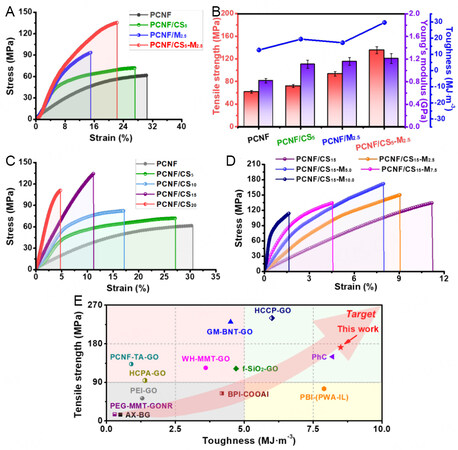
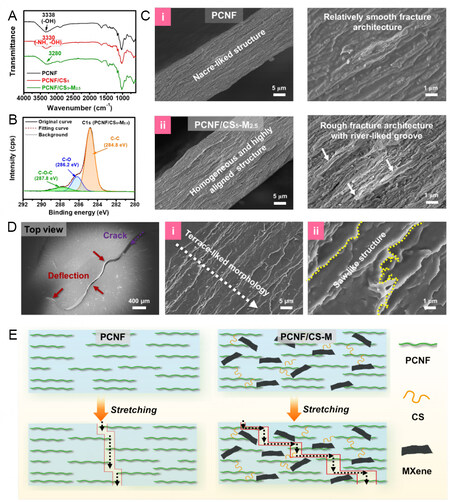
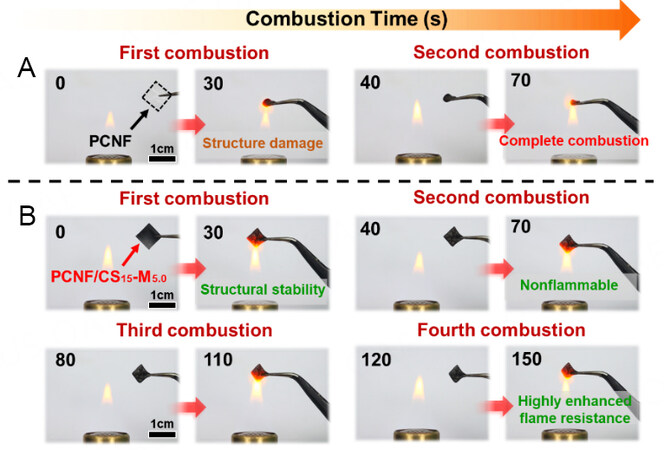
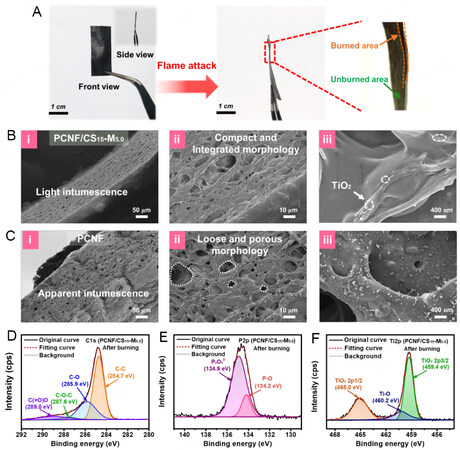
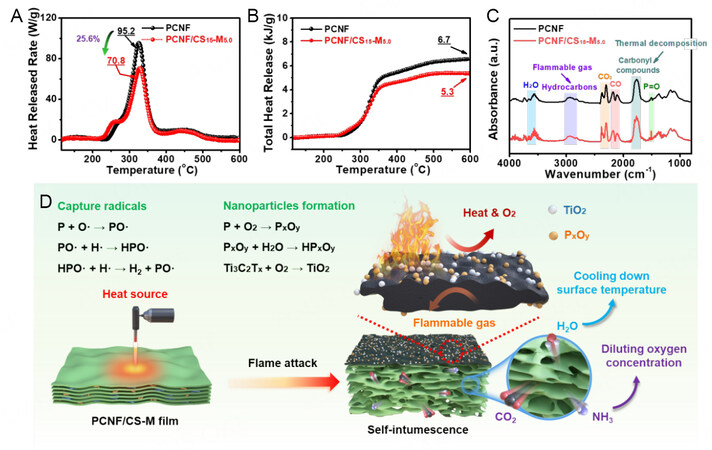











Comments
Comments must be written in English. Spam, offensive content, impersonation, and private information will not be permitted. If any comment is reported and identified as inappropriate content by OAE staff, the comment will be removed without notice. If you have any queries or need any help, please contact us at support@oaepublish.com.